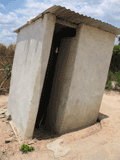Use of latrines Half of the people living with HIV said that they have difficulty using a pit latrine. Many explained that when they are sick and have little strength, they find squatting difficult. One woman uses a bucket inside her home to allow her the comfort of sitting, and then disposes of the waste later. Although this helps her, there is a certain level of discomfort involved and a lack of dignity. There is also an added risk of diarrhoeal disease to those who assist in emptying the bucket, especially if water and soap or ash are not available for washing hands afterwards. Special hygiene guidelines are necessary for people living with HIV and their carers when they are sick. They need to know how to safely dispose of waste containing body fluids, such as using disinfectant and plastic gloves or bags.
Two women explained that they do not use their latrines during the rainy season for fear of falling in because the rainwater puts the latrines at risk of collapse.
Cost of building latrines Although a family may have its own pit latrine at the present time, should this collapse (as is frequent in the rainy season), require repairs or become full, the family may experience difficulties when it becomes necessary to build another. All of the respondents who had basic latrines said they would be unable to replace their latrines should the need arise. Even if a family is physically able to dig, it may lack the tools to make constructing a new latrine possible.
The families that do not have their own latrine reported that they are not able to construct the pit themselves or pay someone to build it for them. These households often have to ask permission to use a neighbour’s latrine or simply use the surrounding outdoor areas. This results in a lack of dignity, health risks and an unattractive environment.
A full version of the study HIV and water: working for positive solutions is available from Action Against Hunger UK. Email: [email protected] Web: www.aahuk.org/publications.htm
Lack of resources
Elena is 16 years old. She lives with her brothers and sisters in a small community on the outskirts of Kitwe city centre. Their pit latrine was built by Elena’s father, but it collapsed after he became sick and they now use the surrounding bush as their toilet. Together, they feel that they would be able to construct a pit latrine, yet their main struggle is locating the tools to do so. With only a small disposable income shared between ten family members, a simple task becomes almost unachievable.
Discussion questions
- What sanitation issues affect people living with or affected by HIV in our local area?
- What ways can be found to enable people who are weakened by HIV-related illnesses to access latrines more easily?
- How can households affected by HIV be supported to build latrines if they do not have the strength or money to do so themselves?
- How might stigma challenge efforts to address the sanitation needs of people living with HIV in our community? What can be done about this?










